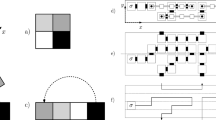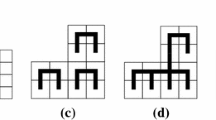Abstract
We investigate a fundamental question regarding a benchmark class of shapes in one of the simplest, yet most widely utilized abstract models of algorithmic tile self-assembly. More specifically, we study the directed tile complexity of a \(\varvec{k}\times \varvec{N}\) thin rectangle in Winfree’s ubiquitous abstract Tile Assembly Model, assuming that cooperative binding cannot be enforced (temperature-1 self-assembly) and that tiles are allowed to be placed at most one step into the third dimension (just-barely 3D). While the directed tile complexities of a square and a scaled-up version of any algorithmically specified shape at temperature 1 in just-barely 3D are both asymptotically the same as they are (respectively) at temperature 2 in 2D, the (nearly tight) bounds on the directed tile complexity of a thin rectangle at temperature 2 in 2D are not currently known to hold at temperature 1 in just-barely 3D. Motivated by this discrepancy, we establish new lower and upper bounds on the directed tile complexity of a thin rectangle at temperature 1 in just-barely 3D. The proof of our upper bound is based on the construction of a novel, just-barely 3D temperature-1 self-assembling counter. Each value of the counter is comprised of \(\varvec{k} - {\textbf {2}}\) digits, represented in a geometrically staggered fashion within \(\varvec{k}\) rows. This nearly optimal digit density, along with the base of the counter, which is proportional to \(\varvec{N}^{\frac{\varvec{1}}{\varvec{k}-{\textbf {1}}}}\), results in an upper bound on the directed tile complexity of a thin rectangle at temperature 1 in just-barely 3D of \(\varvec{O}\left( \varvec{N}^{\frac{{\textbf {1}}}{\varvec{k}-{\textbf {1}}}} + \varvec{k} \right) \), and is an asymptotic improvement over the previous state-of-the-art upper bound. On our way to proving our lower bound, we develop a new, more powerful type of specialized Window Movie Lemma that lets us bound the number of “sufficiently similar” ways to assign glues to a set (rather than a sequence) of fixed locations. Consequently, our lower bound on the directed tile complexity of a thin rectangle at temperature 1 in just-barely 3D of \(\varvec{\Omega }\left( \varvec{N}^{\frac{{\textbf {1}}}{\varvec{k}}} \right) \), is also an asymptotic improvement over the previous state-of-the-art lower bound.




































Similar content being viewed by others
References
Winfree, E.: Algorithmic self-assembly of DNA. PhD thesis, California Institute of Technology (1998)
Seeman, N.C.: Nucleic-acid junctions and lattices. J. Theor. Biol. 99, 237–247 (1982)
Wang, H.: Proving theorems by pattern recognition – II. Bell Syst. Tech. J. XL(1), 1–41 (1961)
Rothemund, P.W.K., Winfree, E.: The program-size complexity of selfassembled squares (extended abstract). In: The Thirty-Second Annual ACM Symposium on Theory of Computing (STOC), pp. 459–468 (2000)
Manuch, J., Stacho, L., Stoll, C.: Two lower bounds for self-assemblies at temperature 1. J. Comput. Biol. 17(6), 841–852 (2010)
Meunier, P.-E., Patitz, M.J., Summers, S.M., Theyssier, G., Winslow, A., Woods, D.: Intrinsic universality in tile self-assembly requires cooperation. In: Proceedings of the Twenty-Fifth Annual ACM-SIAM Symposium on Discrete Algorithms (SODA), pp. 752–771 (2014)
Meunier, P., Woods, D.: The non-cooperative tile assembly model is not intrinsically universal or capable of bounded turing machine simulation. In: Proceedings of the 49th Annual ACM SIGACT Symposium on Theory of Computing, STOC 2017, Montreal, QC, Canada, June 19–23, 2017, pp. 328–341 (2017)
Meunier, P., Regnault, D., Woods, D.: The program-size complexity of self-assembled paths. In: Proceedings of the 52nd Annual ACM SIGACT Symposium on Theory of Computing, STOC 2020, Chicago, IL, USA, June 22-26, 2020, pp. 727–737 (2020)
Doty, D., Patitz, M.J., Summers, S.M.: Limitations of self-assembly at temperature 1. Theor. Comput. Sci. 412, 145–158 (2011)
Demaine, E.D., Demaine, M.L., Fekete, S.P., Ishaque, M., Rafalin, E., Schweller, R.T., Souvaine, D.L.: Staged self-assembly: nanomanufacture of arbitrary shapes with O(1) glues. Nat Comput 7(3), 347–370 (2008)
Doty, D., Patitz, M.J., Reishus, D., Schweller, R.T., Summers, S.M.: Strong fault-tolerance for self-assembly with fuzzy temperature. In: Proceedings of the 51st Annual IEEE Symposium on Foundations of Computer Science (FOCS 2010), pp. 417–426 (2010)
Fekete, S.P., Hendricks, J., Patitz, M.J., Rogers, T.A., Schweller, R.T.: Universal computation with arbitrary polyomino tiles in non-cooperative self-assembly. In: Proceedings of the Twenty-Sixth Annual ACM-SIAM Symposium on Discrete Algorithms, SODA 2015, San Diego, CA, USA, January 4-6, 2015, pp. 148–167 (2015)
Fu, B., Patitz, M.J., Schweller, R.T., Sheline, R.: Self-assembly with geometric tiles. In: Automata, Languages, and Programming - 39th International Colloquium, ICALP 2012, Warwick, UK, July 9-13, 2012, Proceedings, Part I, pp. 714–725 (2012)
Gilbert, O., Hendricks, J., Patitz, M.J., Rogers, T.A.: Computing in continuous space with self-assembling polygonal tiles (extended abstract). In: Proceedings of the Twenty-Seventh Annual ACM-SIAM Symposium on Discrete Algorithms, SODA 2016, Arlington, VA, USA, January 10-12, 2016, pp. 937–956 (2016)
Patitz, M.J., Schweller, R.T., Summers, S.M.: Exact shapes and Turing universality at temperature 1 with a single negative glue. In: Proceedings of the 17th International Conference on DNA Computing and Molecular Programming. DNA’11, pp. 175–189. Springer, Berlin, Heidelberg (2011). http://dl.acm.org/citation.cfm?id=2042033.2042050
Hendricks, J., Patitz, M.J., Rogers, T.A., Summers, S.M.: The power of duples (in self-assembly): It’s not so hip to be square. Theor. Comput. Sci. 743, 148–166 (2018)
Cook, M., Fu, Y., Schweller, R.T.: Temperature 1 self-assembly: Deterministic assembly in 3D and probabilistic assembly in 2D. In: Proceedings of the Twenty-Second Annual ACM-SIAM Symposium on Discrete Algorithms (SODA), pp. 570–589 (2011)
Furcy, D., Micka, S., Summers, S.M.: Optimal program-size complexity for self-assembled squares at temperature 1 in 3D. Algorithmica 77(4), 1240–1282 (2017)
Furcy, D., Summers, S.M., Wendlandt, C.: Self-assembly of and optimal encoding within thin rectangles at temperature-1 in 3D. Theor. Comput. Sci. 872, 55–78 (2021)
Furcy, D., Summers, S.M.: Optimal self-assembly of finite shapes at temperature 1 in 3D. Algorithmica 80(6), 1909–1963 (2018)
Adleman, L.M., Cheng, Q., Goel, A., Huang, M.-D.A.: Running time and program size for self–assembled squares. In: Proceedings of the Thirty–Third Annual ACM Symposium on Theory of Computing (STOC), pp. 740–748 (2001)
Soloveichik, D., Winfree, E.: Complexity of self-assembled shapes. SIAM J. Comput. (SICOMP) 36(6), 1544–1569 (2007)
Aggarwal, G., Cheng, Q., Goldwasser, M.H., Kao, M.-Y., de Espanés, P.M., Schweller, R.T.: Complexities for generalized models of selfassembly. SIAM J. Comput. (SICOMP) 34, 1493–1515 (2005)
Lathrop, J.I., Lutz, J.H., Summers, S.M.: Strict self-assembly of discrete Sierpinski triangles. Theor. Comput. Sci. 410, 384–405 (2009)
Rothemund, P.W.K.: Theory and experiments in algorithmic selfassembly. PhD thesis, University of Southern California (2001)
Lutz, J.H., Shutters, B.: Approximate self-assembly of the sierpinski triangle. Theor. Comput. Syst. 51(3), 372–400 (2012)
Author information
Authors and Affiliations
Corresponding author
Additional information
Publisher's Note
Springer Nature remains neutral with regard to jurisdictional claims in published maps and institutional affiliations.
David Furcy, Scott M. Summers and Logan Withers contributed equally to this work.
Rights and permissions
Springer Nature or its licensor (e.g. a society or other partner) holds exclusive rights to this article under a publishing agreement with the author(s) or other rightsholder(s); author self-archiving of the accepted manuscript version of this article is solely governed by the terms of such publishing agreement and applicable law.
About this article
Cite this article
Furcy, D., Summers, S.M. & Withers, L. Improved Lower and Upper Bounds on the Tile Complexity of Uniquely Self-Assembling a Thin Rectangle Non-Cooperatively in 3D. Theory Comput Syst 67, 1082–1130 (2023). https://doi.org/10.1007/s00224-023-10137-9
Accepted:
Published:
Issue Date:
DOI: https://doi.org/10.1007/s00224-023-10137-9




